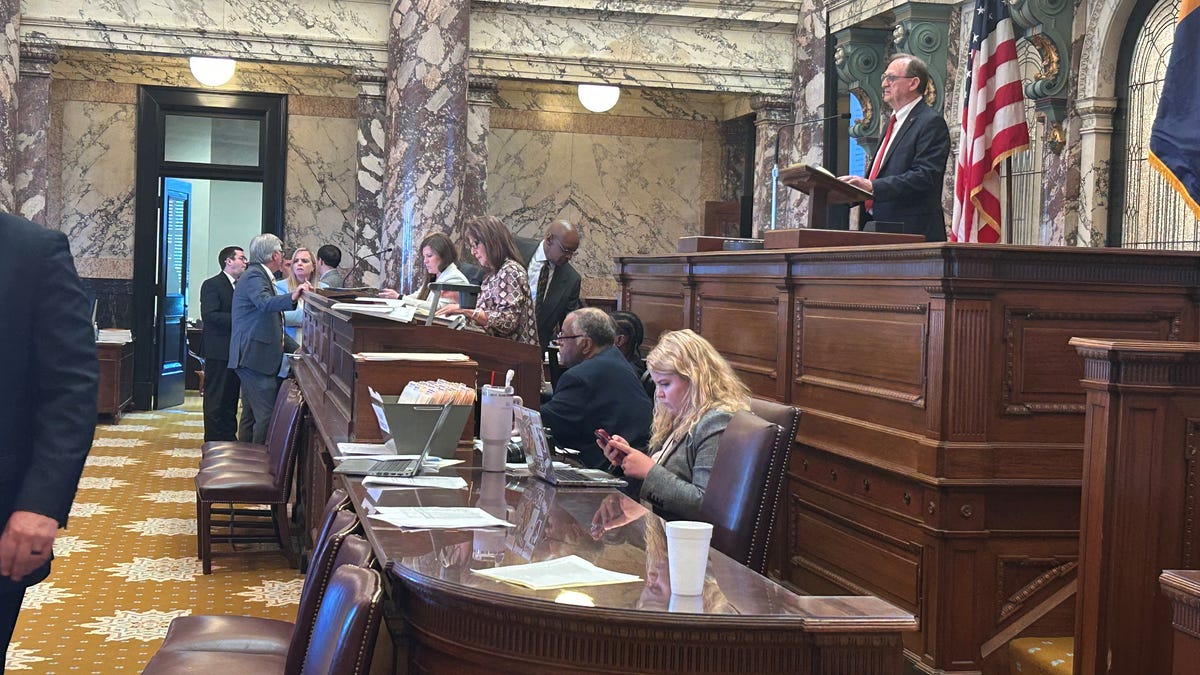One year after the U.S. Supreme Court overturned Roe v. Wade, the right to an abortion remains central to Democrats’ political operations in Wisconsin as the state party seeks to keep U.S. Sen. Tammy Baldwin in office — a key race to keeping the U.S. Senate in Democrats’ hands — and re-elect President Joe Biden next year.
Liberals’ calculus is clear: Most Wisconsinites — and just about all Democrats — favor more permissive abortion policies than the state’s 1849 feticide bill, which has been broadly interpreted to ban abortions in all cases except to save the mother’s life. The issue featured prominently in Democratic Gov. Tony Evers’ reelection in 2022 and helped lead to liberal Justice-elect Janet Protasiewicz’ double digit-winning campaign for the Wisconsin Supreme Court earlier this year.
People are also reading…
Democrats hope it will continue to energize not only liberal voters but also independents and even some Republicans who favor some abortion rights.
“There’s a real irony there … that Republicans finally got what they wanted, in a way, after more than 50 years since Roe v. Wade, but it is costing them electorally,” UW-Madison political science professor Barry Burden said. “The Dobbs (v. Jackson Women’s Health Organization) decision helped keep Democrats competitive in an election cycle where they should have suffered pretty significant losses.”
The decision from the Supreme Court blocks lower court orders that would have restricted the availability of the abortion pill mifepristone nationwide.
At the same time, Democrats’ lawsuit challenging the state’s apparent near-total abortion ban is slowly moving through the courts, likely on its way to the Wisconsin Supreme Court, which will have a liberal majority in August.
Since the ruling, abortion continues to be largely unavailable in Wisconsin, requiring women to travel to nearby states for the procedure. Planned Parenthood reported over 50% more abortion patients in their Illinois clinics since last June, many of them traveling from out of state. The group’s Minnesota clinics had a 25% increase, Minnesota Public Radio reported.
As the one-year anniversary of the Dobbs decision approached last week, Wisconsin Democrats made clear the issue would factor heavily into their 2024 campaigns.
The Democratic National Committee on Wednesday announced an ad campaign in Wisconsin including abortion rights billboards in Milwaukee and digital ads on social media.
“The fight for reproductive freedom is on in 2024,” Wisconsin Democratic Party chair Ben Wikler said, adding that the biggest question is whether there will be federal legislation to protect abortion rights or a national abortion ban.
Baldwin echoed those concerns in a video last week.
“I refuse to let the next generation of women be left with fewer rights than their mothers and grandmothers,” she said.
I refuse to let the next generation of women be left with fewer rights than their mothers and grandmothers. https://t.co/H1HfCH7F1u
— Sen. Tammy Baldwin (@SenatorBaldwin) June 22, 2023
Wisconsin Republicans, meanwhile, have remained mostly silent on the issue. Republican Party of Wisconsin spokesperson Rachel Reisner didn’t respond to a request for an interview with party chair Brian Schimming.
Instead, they’ve focused on issues they’re better positioned on, such as inflation and crime, Burden said.
Republicans have also sought to “soften the hard edge” on Wisconsin’s abortion ban through proposals to add exceptions for rape and incest, or suggesting putting the matter to a referendum, as proposed by U.S. Sen. Ron Johnson, R-Oshkosh.
“So far, neither of those strategies … have been very effective,” Burden said.
No consensus
The parties’ different approaches reflect a divide across the nation that favors Democrats when it comes to abortion: 42% of the public say the Democratic Party best represents their views on abortion, compared with 26% who said the same about the Republican Party, the Kaiser Family Foundation found. Just 10% of self-identified Democrats said their party doesn’t represent their views on abortion, compared with 27% of Republicans.

Both parties have introduced several abortion bills in the past year, all of which have gone nowhere in a state where the Legislature is controlled by Republicans and the governor’s office is held by a Democrat.
In March, Assembly Speaker Robin Vos, R-Rochester, proposed a bill to add exceptions for rape and incest to the state ban. But Evers said he wouldn’t sign any abortion bill that leaves that 1849 law in effect. Soon after, Senate Majority Leader Devin LeMahieu, R-Oostburg, said the Senate wouldn’t even take up the bill given the certainty of a veto.
Since then, Republicans introduced measures clarifying that several medical procedures that could lead to the death of a fetus wouldn’t be categorized as abortions. The bills haven’t received a vote yet. Even if they do, Evers would almost certainly veto those, too, because they would leave the 1849 ban active.
Democratic proposals have been equally unsuccessful. Democratic lawmakers have proposed abortion legislation that hasn’t received a public hearing. Evers called for the Legislature into two special sessions to repeal the state’s 1849 ban and have voters weigh in on the ban, but Republicans quickly gaveled out of both meetings.
Bound for court?
That means the likeliest venue for resolving the state’s abortion debate is in the courts.
Days after the Dobbs decision, Democratic Attorney General Josh Kaul challenged the state’s abortion ban, which hadn’t been enforced since Roe established a constitutional right to abortion in 1973.
Kaul argued that subsequent, more permissive abortion bans effectively obviated the ban. He also alleged the law has been out of use for so long that it can no longer be considered to be in effect.

While most of the hearings on the case so far have involved procedural issues, Dane County Circuit Judge Diane Schlipper questioned whether part of the law being challenged by Kaul only prohibits killing a fetus without the mother’s consent, not consensual abortions.
Whatever becomes of the case, it’s almost certainly headed to the Wisconsin Supreme Court, which will have a liberal majority for the first time in 15 years after the election of Protasiewicz, who was unusually frank in discussing her support for abortion rights during the campaign.

If the court does grant more abortion rights before the 2024 elections, Burden said, “Democrats will have to diversify their arguments, their messaging to voters,” beyond abortion.
The Supreme Court fight over an abortion pill: What’s next?
Intro

The Supreme Court initially gave itself a deadline of Wednesday to decide whether women seeking access to a widely used abortion pill would face more restrictions while a court case plays out. But on the day of the highly anticipated decision the justices had only this to say: We need more time.
In a one-sentence order, the court said it now expects to act by Friday evening. There was no explanation of the reason for the delay.
The new abortion controversy comes less than a year after the Supreme Court’s conservative majority overturned Roe v. Wade and allowed more than a dozen states to effectively ban abortion outright.
The following is a look at the drug at issue in the new case, how the case got to the nation’s highest court and what the delay might say about what’s going on.
What is mifepristone?

Mifepristone was approved for use by the Food and Drug Administration more than two decades ago. It has been used by more than 5 million women to safely end their pregnancies, and today more than half of women who end a pregnancy rely on the drug, the Justice Department said.
Over the years, the FDA has loosened restrictions on the drug’s use, extending from seven to 10 weeks of pregnancy when it can be used, reducing the dosage needed to safely end a pregnancy, eliminating the requirement to visit a doctor in person to get it and allowing pills to be obtained by mail. The FDA also approved a generic version of mifepristone that its manufacturer, Las Vegas-based GenBioPro, says makes up two-thirds of the domestic market.
Mifepristone is one of two pills used in medication abortions, along with misoprostol. Health care providers have said they could switch to misoprostol only if mifepristone is no longer available or is too hard to obtain. Misoprostol is somewhat less effective in ending pregnancies.
How did the case get started?

A lawsuit over mifepristone was filed in Amarillo, Texas, late last year. Alliance Defending Freedom, a conservative Christian legal group, represents the pill’s opponents, who say the FDA’s approval of mifepristone was flawed.
Why Amarillo? U.S. District Judge Matthew Kacsmaryk (pictured), who was nominated by then-President Donald Trump, is the sole district court judge there, ensuring that all cases filed in the west Texas city land in front of him. Since taking the bench, he has ruled against President Joe Biden’s administration on several other issues, including immigration and LGBTQ protections.
On April 7, Kacsmaryk issued a ruling that would revoke the FDA’s approval of mifepristone, but he put the decision on hold for a week to allow an appeal.
Complicating matters, however, on the same day Kacsmaryk issued his order, a court in Washington state issued a separate ruling in a lawsuit brought by liberal states seeking to preserve access to mifepristone. The Washington judge, Spokane-based Thomas O. Rice, whom then-President Barack Obama nominated, ordered the FDA not to do anything that might affect the availability of mifepristone in the suing states. The Biden administration has said it is impossible to follow both judges’ directives at the same time.
How did the case get to the Supreme Court?

The Biden administration responded to Kacsmaryk’s ruling by asking the New Orleans-based 5th U.S. Circuit Court of Appeals to prevent it from taking effect for now.
Last week, the appeals court narrowed Kacsmaryk’s ruling so that the initial approval of mifepristone in 2000 is not affected, for now. But it agreed with him that changes the FDA made to relax the rules for prescribing and dispensing the drug should be put on hold. Those rules included expanding when the drug could be taken and allowing for the drug’s delivery through the mail.
The appeals court acted by a 2-1 vote. The judges in the majority, Kurt Engelhardt and Andrew Oldham, are both Trump picks.
The Biden administration and the maker of mifepristone, New York-based Danco Laboratories, appealed to the Supreme Court, saying that allowing the appeals court’s restrictions to take effect would cause chaos. Facing a tight deadline, the Supreme Court gave itself some breathing room and issued an order suggesting it would act by Wednesday evening. That timeline was extended to Friday, the day the justices will hold a previously scheduled private conference.
The justices could talk about the issue further then. The additional time could also be part of an effort to craft an order that has broad support among the nine justices. Or one or more justices might be writing a separate opinion and asked for a couple of extra days.
About the photo: Laura Meyers, CEO of Planned Parenthood Metropolitan Washington DC, speaks during a Planned Parenthood rally in support of abortion access outside the Supreme Court on Saturday, April. 15, 2023, in Washington.
What could happen next?

The Supreme Court’s delay suggests a maddening reality about an institution that ordinarily adheres to a schedule that hasn’t changed much in years: Even experts can be in the dark about when the court will decide things and how.
Cases are argued over seven months from October to April, and the most important decisions typically come right before the justices take a long summer break. The court does not say which cases it plans to hand down on a given day, and the court, in a search for consensus, will sometimes pass on the biggest issues it faces and decide a very small legal point.
But nowhere is the uncertainty as great as a separate category of cases that have come to be known as the shadow docket.
Apart from death row inmates seeking 11th-hour reprieves, shadow docket cases generally involve emergency appeals to the justices before lower courts have reached final decisions. That includes the mifepristone case.
When the justices consider this set of cases, they don’t usually have a deadline to act. A few years back, an order concerning an elections case in Texas came in the wee hours of a Saturday morning for no reason other than that’s when Justice Ruth Bader Ginsburg finished work on her dissenting opinion.
A closer look




:focal(0x0:3000x2000)/static.texastribune.org/media/files/c00eed6d9f45b6e1ebacbb76d9df1920/0127%20School%20Choice%20Lufkin%20CO%20TT%2020.jpg)

:focal(1x431:2999x2000)/static.texastribune.org/media/files/8b56b90163b9181591141e02785a95c5/0422%20We%20Wont%20Go%20Back%20Presser%20TT%20EG%2005.jpg)
:focal(0x197:3500x2274)/static.texastribune.org/media/files/9c35b3883c705663a20ccf875b8cd126/Ralls%20Drought%20TTh%20TT%2021.jpg)
























